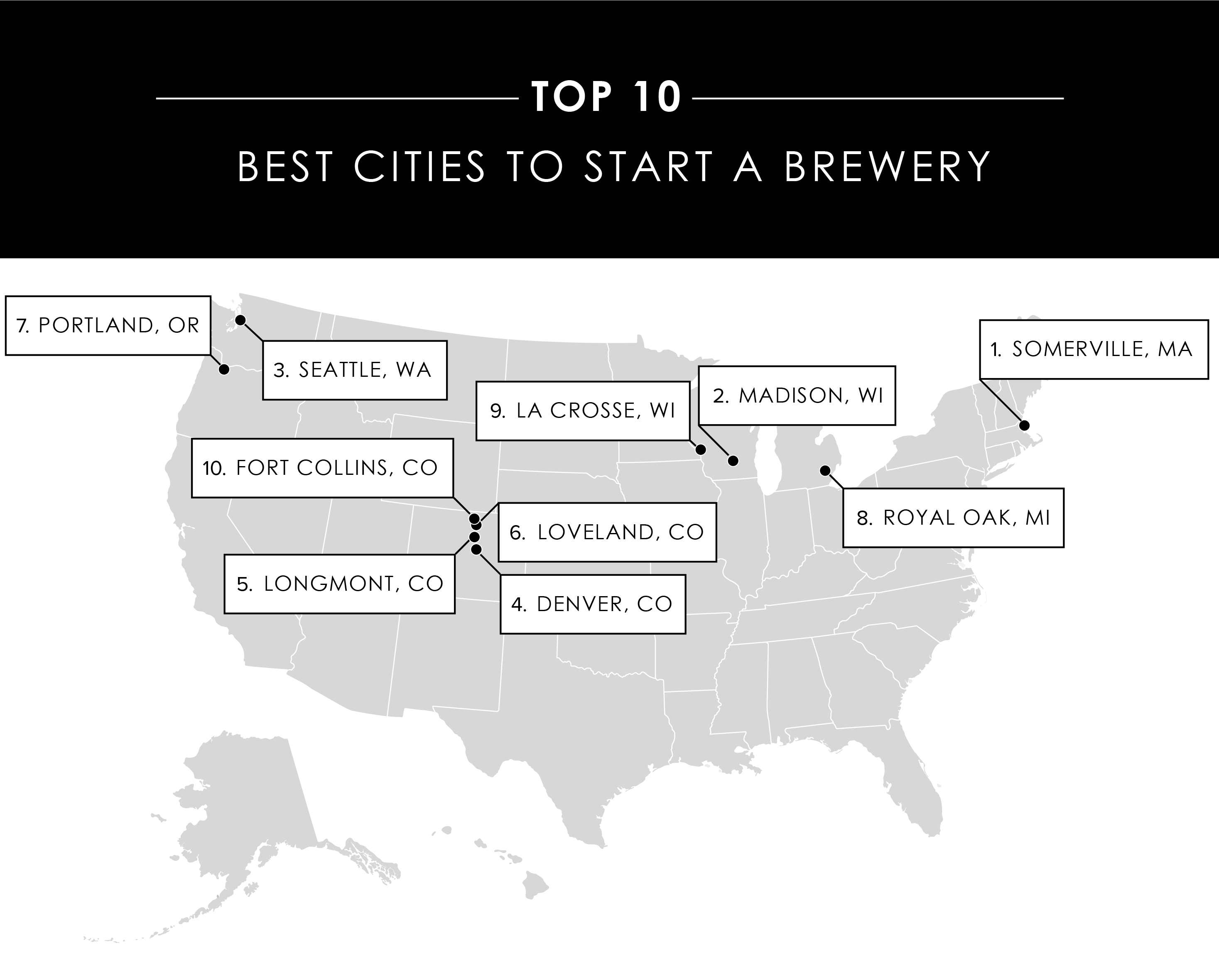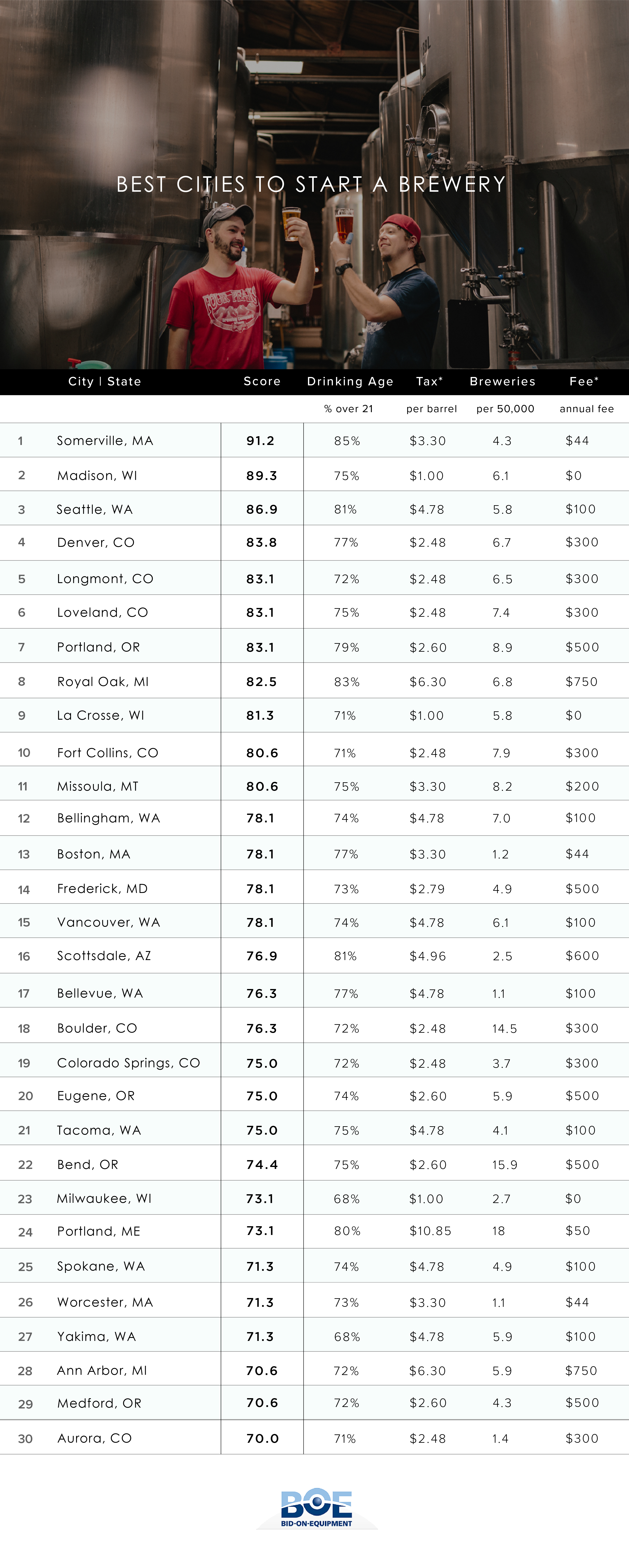Beer fermenters, kegs, pumps, brewhouse equipment and a great tasting beer are only some of the ingredients in creating a successful brewery. There are plenty of other key factors brewers and brew masters need to be aware of before tapping into the beer business and opening a brewery of their own.

We dug deeper into those factors and analyzed data from hundreds of cities across the country to find the best cities to open a brewery. Our analysis includes everything from annual license fees and self-distribution laws to breweries per capita and median income. The list below highlights cities that provide the greatest potential for aspiring brewery owners.
Craft beer’s popularity has skyrocketed throughout the past decade, which means the opportunity is ripe to start a brewery. According to the Brewers Association, the number of craft breweries in the U.S. has grown from just under 1,500 in 2007 to more than 7,000 as of July 2018. Considering those numbers, there’s a good chance that a brewery isn’t too far from where you live, especially if you’re a Coloradoan. Our list of the top 30 cities to open a brewery features five Colorado cities, four of which have at least 6 or more breweries per 50,000 people.

It’s interesting to note that large metropolitan cities are scarce on our list. In fact, only five cities on our list have a population of 500,000 or more. Many small cities such as Royal Oak, Michigan; Bend, Oregon and Longmont, Colorado top our list. Speaking of Colorado and Oregon, both states make the most appearances on the top 25 list. There are six cities representing Colorado and four representing Oregon.
With a population of less than 100,000 people, the small but densely-populated city of Somerville, Massachusetts tops our list with an overall score of 91.2. The city has the highest percent of 21+ population on the list as well as a low state excise tax on barrels of beer along with one of the lowest brewery license fees in the country.
If craft beer’s popularity continues to grow it will be interesting to see what cities hold onto their rank and what newcomers emerge.
Methodology
To determine our ranking, we looked at census-defined places with at least 50,000 people in the 2017 5-Year U.S. Census’ American Community Survey. We compared these cities across two key categories, “Business Environment” and “Business Costs.”
Within those categories, we measured six different metrics, which are listed below along with their corresponding weights. Each metric was graded on a 100-point scale. Data for metrics with an asterisk (*) were only available on the state level.
To determine an overall score, each city’s weighted average was calculated across all metrics.
Business Environment - 50 Points
- Percent of population age 21 or over: 12.5 points
- Number of breweries per 50,000 people: 12.5 points
- Self-distribution* (If state allows breweries to self-distribute): 12.5 points
- Median income: 12.5 points
Business Costs - 50 Points
- State excise tax per barrel*: 25 points
- Brewery license cost*: 25 points
Why state excise tax was included within rankings: According to the Beer Institute, a national trade association for the American brewing industry, “Taxes are the single most expensive ingredient in beer, costing more than the labor and raw materials combined.” Research has shown that approximately 40 percent of the retail price of beer is dedicated toward covering all applicable taxes. State excise tax was analyzed from the Brewers Association and based on microbreweries that are classified as selling less than 15,000 barrels per year.
Outliers: In order to consider oversaturation within the market, cities with more than 10 breweries per capita were calculated as outliers and therefore given a lesser grade.
Sources: U.S. Census Bureau, Brewers Association, Beer Institute, BreweryDB.com
For media inquiries, contact media@digitalthirdcoast.net
Fair Use
Feel free to use this data and research with proper attribution linking to this study.